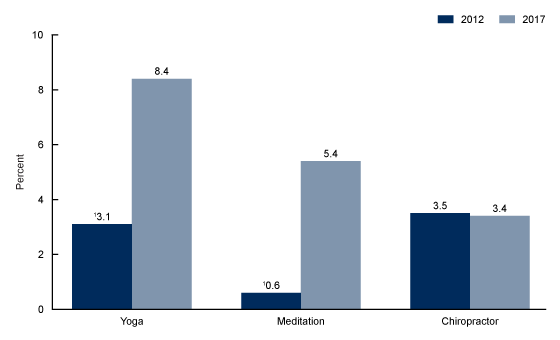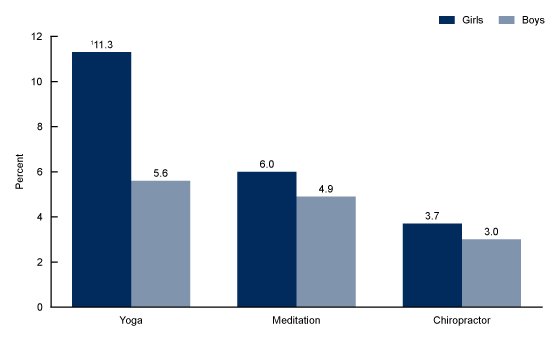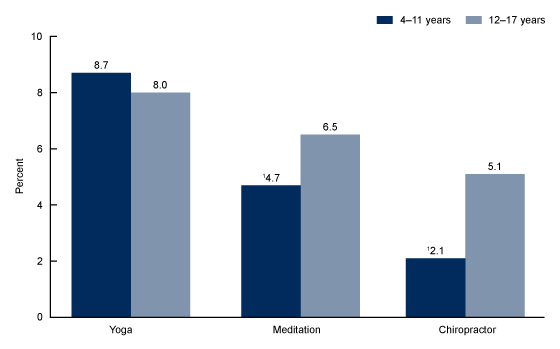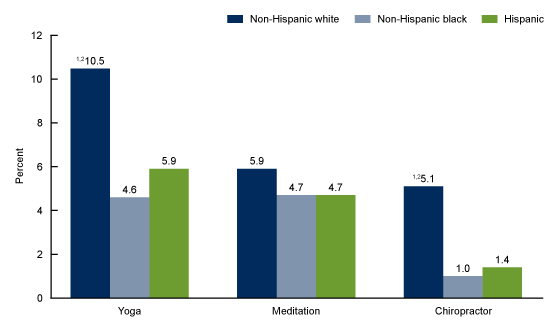Use of Yoga, Meditation, and Chiropractors Among U.S. Children Aged 4–17 Years
- Key findings
- Were there changes in children’s use of yoga, meditation, or chiropractors from 2012 to 2017?
- Did the use of yoga, meditation, or chiropractors vary by sex?
- Did the use of yoga, meditation, or chiropractors vary by age group?
- Did the use of yoga, meditation, or chiropractors vary by race and Hispanic origin?
- Summary
- Definition
- Data source and methods
- About the authors
- References
- Suggested citation
PDF Version (480 KB) | Visual Abstract
Lindsey I. Black, M.P.H., Patricia M. Barnes, M.A., Tainya C. Clarke, Ph.D., M.P.H., Barbara J. Stussman, B.A., and Richard L. Nahin, Ph.D., M.P.H.
Key findings
Data from the National Health Interview Survey, 2012 and 2017
- Among children aged 4–17 years, the use of yoga and meditation during the past 12 months increased from 2012 to 2017.
- In 2017, girls were more likely to have used yoga during the past 12 months than boys.
- In 2017, older children (aged 12–17 years) were more likely to have used meditation and a chiropractor in the past 12 months than younger children (aged 4–11 years).
- Non-Hispanic white children were more likely to have used yoga and a chiropractor in the past 12 months than non-Hispanic black children or Hispanic children.
Yoga, meditation, and use of chiropractors are types of complementary health approaches developed outside of mainstream Western medicine (1,2). Although complementary health approaches as a whole are not widely used among children, previous work has established a rise in the use of selected approaches over time (3). This report presents the most recent national estimates of use of the three most prevalent approaches during the past 12 months, among children aged 4–17 years in the United States. Comparable estimates from 2012 are also included to examine changes over time.
Keywords: complementary health approaches, National Health Interview Survey
Were there changes in children’s use of yoga, meditation, or chiropractors from 2012 to 2017?
The percentage of children aged 4–17 years who used yoga in the past 12 months increased significantly from 3.1% in 2012 to 8.4% in 2017 (Figure 1). Meditation increased significantly from 0.6% in 2012 to 5.4% in 2017. Use of a chiropractor showed no statistically significant difference from 2012 to 2017 (3.5% and 3.4%, respectively).
Figure 1. Age-adjusted percentage of children aged 4–17 years who used yoga, meditation, or a chiropractor during the past 12 months, by year: United States, 2012 and 2017
1Significantly different from 2017 (p < 0.05).
NOTES: Estimates are age adjusted using the projected 2000 U.S. population as the standard population and two age groups: 4–11 and 12–17 years. Estimates are based on household interviews of a sample of the U.S. civilian noninstitutionalized population. Access data table for Figure 1.
SOURCE: NCHS, National Health Interview Survey, 2012 and 2017.
Did the use of yoga, meditation, or chiropractors vary by sex?
Girls (11.3%) were significantly more likely to have used yoga in the past 12 months compared with boys (5.6%) (Figure 2). No significant differences were seen between boys and girls in the use of meditation or a chiropractor.
Figure 2. Age-adjusted percentage of children aged 4–17 years who used yoga, meditation, or a chiropractor during the past 12 months, by sex: United States, 2017
1Significantly different from boys (p < 0.05).
NOTES: Estimates are age adjusted using the projected 2000 U.S. population as the standard population and two age groups: 4–11 and 12–17 years. Estimates are based on household interviews of a sample of the U.S. civilian noninstitutionalized population. Access data table for Figure 2.
SOURCE: NCHS, National Health Interview Survey, 2017.
Did the use of yoga, meditation, or chiropractors vary by age group?
The percentage of children aged 4–11 years (8.7%) that used yoga in the past 12 months was similar to that of children aged 12–17 years (8.0%) (Figure 3). Older children were more likely to have used meditation (6.5%) and a chiropractor (5.1%) than younger children (4.7% and 2.1%, respectively).
Figure 3. Percentage of children aged 4–17 years who used yoga, meditation, or a chiropractor during the past 12 months, by age group: United States, 2017
1Significantly different from children aged 12–17 years (p < 0.05).
NOTES: Estimates are based on household interviews of a sample of the U.S. civilian noninstitutionalized population. Access data table for Figure 3.
SOURCE: NCHS, National Health Interview Survey, 2017.
Did the use of yoga, meditation, or chiropractors vary by race and Hispanic origin?
Non-Hispanic white (10.5%) children were more likely than non-Hispanic black (4.6%) and Hispanic (5.9%) children to have used yoga in the past 12 months (Figure 4). No significant differences were seen in the use of meditation by race and Hispanic origin. Non-Hispanic white (5.1%) children were more likely to have used a chiropractor than non-Hispanic black (1.0%) and Hispanic (1.4%) children.
Figure 4. Age-adjusted percentage of children aged 4–17 years who used yoga, meditation, or a chiropractor during the past 12 months, by race and Hispanic origin: United States, 2017
1Significantly different from non-Hispanic black children (p < 0.05).
2Significantly different from Hispanic children (p < 0.05).
NOTES: Estimates are age adjusted using the projected 2000 U.S. population as the standard population and two age groups: 4–11 and 12–17 years. Estimates are based on household interviews of a sample of the U.S. civilian noninstitutionalized population. Access data table for Figure 4.
SOURCE: NCHS, National Health Interview Survey, 2017.
Summary
From 2012 to 2017 among children aged 4–17 years, significant increases were seen in children’s use of yoga and meditation during the past 12 months. However, there was no change in their use of a chiropractor in the past 12 months.
In 2017, 8.4% of children (4.9 million) aged 4–17 years used yoga, 5.4% (3.1 million) used meditation, and 3.4% (2.0 million) used chiropractic services. The current analyses found demographic differences in the use of these three modalities. Girls were more likely to have used yoga in the past 12 months compared with boys. Children aged 12–17 years were more likely to have used meditation and a chiropractor than children aged 4–11 years. Non-Hispanic white children were more likely to have used yoga and a chiropractor than both non-Hispanic black children and Hispanic children. Differences in the use of selected approaches by sex, age, and race and Hispanic origin are consistent with patterns of use in previous years (3).
Definitions
Chiropractor: A person who performs hands-on therapy concerned with the diagnosis and treatment of mechanical disorders of the musculoskeletal system, primarily the spine, and its function.
Meditation: A composite measure based on responses to three questions that determined the use of: 1) mantra meditation, including transcendental meditation, relaxation response, and clinically standardized meditation; 2) mindfulness meditation, including vipassana, Zen Buddhist meditation, mindfulness-based stress reduction, and mindfulness-based cognitive therapy; and 3) spiritual meditation, including centering prayer and contemplative meditation.
Race and Hispanic origin: Based on responses to two questions that determine Hispanic or Latino origin and race. Persons of Hispanic or Latino origin may be of any race. Non-Hispanic white and non-Hispanic black refer to children with a single race group indicated. Data for children with more than one race group indicated or of other race groups are not shown in this report.
Yoga: A combination of breathing exercises, meditation, and physical postures, of Hindu origin, used to achieve a state of relaxation and balance of mind, body, and spirit.
Data source and methods
Data from the 2012 and 2017 National Health Interview Survey (NHIS) were used for this analysis. NHIS is a nationally representative survey of the U.S. civilian noninstitutionalized population. It is conducted continuously throughout the year by the National Center for Health Statistics (NCHS). NHIS is an in-person interview conducted in the respondent’s home. In some instances, follow-up to complete the interview is conducted via telephone. For further information about NHIS, including the questionnaire, visit the NHIS website.
Information on the use of complementary health approaches was collected from respondents for sample children aged 4–17 years as part of the Child Alternative Medicine (2012) or Child Complementary Health (2017) supplements of NHIS. For both survey years, respondents were asked about the use of selected complementary health approaches in the past 12 months, including whether they saw a complementary health provider or practitioner for this approach. However, in 2012, respondents were first asked if they ever used the approach, and those who responded “yes” were then asked about their more recent use. These preliminary questions were not asked in 2017. Respondents could answer yes to use of more than one complementary health approach. The percentage of children who saw a chiropractor in the past 12 months was obtained from the “Child Access to Health Care and Utilization (CAU)” section of the Sample Child file in both 2012 and 2017.
NHIS is designed to yield a nationally representative sample, and these analyses used weights to produce national estimates. The sample design is described in more detail elsewhere (4, 5). Point estimates and the corresponding variances for this analysis were calculated using SUDAAN software (6) to account for the complex sample design of NHIS. Differences between percentages were evaluated using two-sided significance tests at the 0.05 level with no adjustments made for multiple comparisons. All estimates in this report meet NCHS standards of reliability as specified in “National Center for Health Statistics Data Presentation Standards for Proportions” (7).
About the authors
Lindsey I. Black and Tainya C. Clarke are with the National Center for Health Statistics, Division of Health Interview Statistics. Patricia M. Barnes is with the National Center for Health Statistics, Division of Research and Methodology. Barbara J. Stussman and Richard L. Nahin are with the National Institutes of Health, National Center for Complementary and Integrative Health.
References
- National Center for Complementary and Integrative Health. Complementary, alternative, or integrative health: What’s in a name? NCCIH Publication No. D347. 2018.
- National Center for Complementary and Alternative Medicine. Exploring the science of complementary and alternative medicine. Third strategic plan: 2011–2015. Washington, DC: U.S. Department of Health and Human Services, National Institutes of Health. NIH Publication No. 11–7643, D458. 2011.
- Black LI, Clarke TC, Barnes PM, Stussman BJ, Nahin RL. Use of complementary health approaches among children aged 4–17 years in the United States: National Health Interview Survey, 2007–2012 [PDF – 299 KB]. National Health Statistics Reports; no 78. Hyattsville, MD: National Center for Health Statistics. 2015.
- National Center for Health Statistics. Survey description, National Health Interview Survey, 2012. Hyattsville, MD. 2013.
- National Center for Health Statistics. Survey description, National Health Interview Survey, 2017. Hyattsville, MD. 2018.
- RTI International. SUDAAN (Release 11.0.0) [computer software]. 2012.
- Parker JD, Talih M, Malec DJ, Beresovsky V, Carroll M, Gonzales, JF Jr, et. al. National Center for Health Statistics Data Presentation Standards for Proportions. National Center for Health Statistics. Vital Health Stat 2(175). 2017.
Suggested citation
Black LI, Barnes PM, Clarke TC, Stussman BJ, Nahin RL. Use of yoga, meditation, and chiropractors among U.S. children aged 4–17 years. NCHS Data Brief, no 324. Hyattsville, MD: National Center for Health Statistics. 2018.
Copyright information
All material appearing in this report is in the public domain and may be reproduced or copied without permission; citation as to source, however, is appreciated.
National Center for Health Statistics
Charles J. Rothwell, M.S., M.B.A., Director
Jennifer H. Madans, Ph.D., Associate Director for Science
Division of Health Interview Statistics
Stephen J. Blumberg, Ph.D., Director
Robin A. Cohen, Ph.D., Acting Associate Director for Science
Division of Research and Methodology
Jennifer D. Parker, Ph.D., Director
Donald J. Malec, Ph.D., Associate Director for Science



